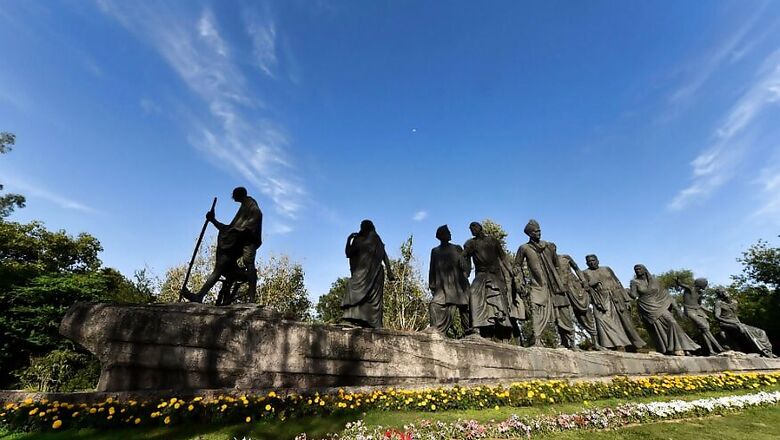
views
The national lockdown imposed earlier this year to control the Covid-19 pandemic significantly improved air quality in seven cities across the country. However, semi-urban and rural regions did not see improvements on a similar scale. These findings were revealed as part of the Central Pollution Control Board’s (CPCB) study on the impact of lockdown on ambient air quality. CPCB is the country’s top pollution watchdog and works under the Union environment ministry.
Data from the network of air quality monitoring stations and satellite data were analysed to arrive at these trends. Besides the lockdown, meteorological factors, topography and influence of coastal conditions, especially in the case of Mumbai, Chennai and Kolkata also affected air quality.
The study also included a source apportionment study of pollution sources in Delhi city, which showed that reduction in vehicular emissions and local combustion helped in improving the capital’s air quality. The improvements in air quality varied in nature from city to city. Some cities, like Delhi, saw improvements in both phases of lockdown, early and middle phase, while some like Mumbai saw more improvements during the middle phase of lockdown between April and May.
Delhi saw a 24% reduction in particulate matter 2.5 (PM 2.5) in the pre-lockdown period (March). But it dropped drastically, by nearly 50% during the late March to mid-May period compared to the levels seen in 2019. Particulate matter 10 (PM 10) levels reduced by a massive 60%, NO2 (nitrogen oxide) levels fell by 64%, Benzene by 62% and SO2 (Sulphur Dioxide) by 35% during the second phase of the lockdown as compared to levels in corresponding period in 2019, the CPCB report stated.
In Mumbai, during the first phase of lockdown, a reduction of 68% was seen in SO2 levels, NO2 levels dropped by 56% and there was 20% reduction in PM10 levels against 2019 levels. The reduction in NO2 and PM10 levels further increased in the second phase of lockdown to 69% and 40%, respectively, when compared to the same time period in 2019, the CPCB report said.
Source Apportionment Study: Which Pollution Sources Showed Reduction in Levels?
As part of the study on air quality improvements, CPCB also commissioned a source apportionment study for Delhi to analyse the trends in different sources of pollutions during the lockdown period. The study, carried out by Indian Institute of Technology – Kanpur, revealed that vehicular emissions, domestic coal combustion, waste incineration and urban organic aerosols reduced sharply from pre-lockdown period to phase I of lockdown (March to April). However, as the government began easing relaxations, pollution from these sources began rising once again.
During the first phase of lockdown, the share of vehicular emissions in overall pollution dropped to 5% from 19%. Similarly, both the coal combustion and waste incineration factors, which were found to be originating from local/domestic sources decreased steadily, the report showed.
Black carbon pollution, emitted from biomass burning and vehicular traffic dropped to 6% during the first phase of the lockdown. Delhi has three major landfills at Bhalswa, Ghazipur and Okhla, and all are overflowing.
To put things into perspective, a 2018 source apportionment study by The Energy and Research Institute and Automotive Research Association of India had found out that during summers, transport sector contributes 15-17% of particulate matter in Delhi, industry contributes 22% whereas dust and construction activities are the biggest source, at 38-42%.
Drop in Vehicular Emissions, Local Combustion in Cities, Low Changes in Rural Areas
CPCB’s analysis showed that the drop in mobility and the consequent reduction in vehicular emissions, drop in local combustion and urban aerosols, and even coal usage were some of the prime reasons for improvement in air quality in cities. Satellite-based assessment of PM 2.5 data though showed an underwhelming picture at the regional level. Use of solid fuels, agricultural burning during summer continued to contribute to particulate pollution and black carbon in semi-urban and rural areas.
Household emissions are likely to have remained the same or may have even increased with large number of people indoors, the report said, and agricultural burning during wheat harvest was also observed, it added.
“Both of these sources contributed to regional PM2.5 and perhaps also to the downwind urban areas through secondary aerosol formation. The initial improvement in air quality during the first phase of lockdown could not be sustained in the subsequent phases over a large part of the country due to sustained emissions from household sources and open biomass burning,” the report stated.
Singrauli, which is considered the coal capital of the country owing to the presence of many coal-fired power stations, showed a considerable decline in major pollutants. The decline though was short-lived and pollution rose again during the April-May period.
The average concentration of three key pollutants – PM10, PM2.5 and NO2 – declined during the pre-lockdown period and during the March-May period in comparison to 2019 data of the same period. During the April-May period, PM10 decreased by 45%, PM2.5 decreased by 36% and NO2 decreased by 7%.
However, the sulphur dioxide levels were higher compared to 2019 levels. CPCB attributed this rise to the coal mines, coal-fired power plants, summer conditions and related meteorological factors and rise in power demand due to summer.




















Comments
0 comment